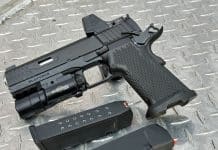Here at Guns&Tactics, we tend to focus more on the Guns and not so much on the Tactics. Our partners over at SpotterUp.com recently published a quick and dirty post showing the basics of Cornering. Tactically, of course.
Adversity has the effect of eliciting talents, which in prosperous circumstances would have lain dormant. Horace
We want to restate this article is not a "be-all" "end-all" article that will solve every 'tactical' problem. It is written solely to introduce the concept of tactical movement to those with little experience or knowledge in this area. Theory and Reality are two different things; what works in the classroom will not always work in "life". Spotter Up will assume "no" responsibility for any use or misuse of information from this article. This article alone will not make the reader an expert in tactics or in firearms nor can it be used as a substitute for PROFESSIONAL TACTICAL TRAINING or WEAPONS TRAINING. Spotter Up advises you to visit our site for training courses with a certified instructor On ALL weapon platforms.

Circumstances are an attribute, detail, or condition with respect to time, place, manner, agent, etc., that accompanies, determines, or modifies a fact or event; it is a modifying or influencing factor. Keeping this in mind, know then, there are no fail safe entries. Every entry by units has pros and cons and there are far too many elements to list here. Trying to list every element would only cause more confusion. Practicing a technique will elicit the reasons why.

Always Practice
There isn't a magic tactic that will solve all of your tactical problems but practicing tactic movements can give you a better sense of how angles work.
Observe your corner
Stand about an arm's-length away from the corner. An arm's-length distance opens up your view a bit while still providing you some concealment. Don't lean on the wall or let your equipment scrape the wall or you might give away your position. Don't let your firearm stick out into the doorway (anything beyond the corner) or you will expose yourself to ninjas.

Slicing the Pie
The process of traversing a corner is known as Slicing the Pie. A potentially dangerous area can be managed best by breaking it down into smaller sections. This can be done using distance and angles to look around a corner without unnecessarily exposing yourself. Look at our picture below. This particular pie is sectioned off in three (3) pieces (marked as 1, 2, 3) that you can potentially use to swing around the apex of the corner in order to open up your field of view.

When Slicing the Pie, you begin as soon as you recognize the corner. If you have some distance from the corner, then use the space available to increase your field of view and reactionary gap. Adjust your upper body to the threat.
Slowing your advance as you get closer to the corner gives you sufficient time to react to threats. *Operator in the Front can step from position 1 to position 3 and slowly look around the corner, while the *Operator in the Rear can move up alongside his partner.

Beware the ninjas!

Learning to clear corners is easiest if you have a partner because he can become the bad guy. He can place himself in various places in the unknown threat area, and help you understand how to hone your observation and moving skills.
Try not to expose any part of your body or weapon when you begin to move around the corner. Be patient and the gains will come.
Images property of Spotterup. Please use as you want but please give Spotterup credit.
Main image from Project Gecko.com
*Operator: Officer/Troop member

* The views and opinions expressed on this web site are solely those of the original authors and contributors. These views and opinions do not necessarily represent those of Guns & Tactics Magazine,
the administrative staff, and/or any/all contributors to this site.












